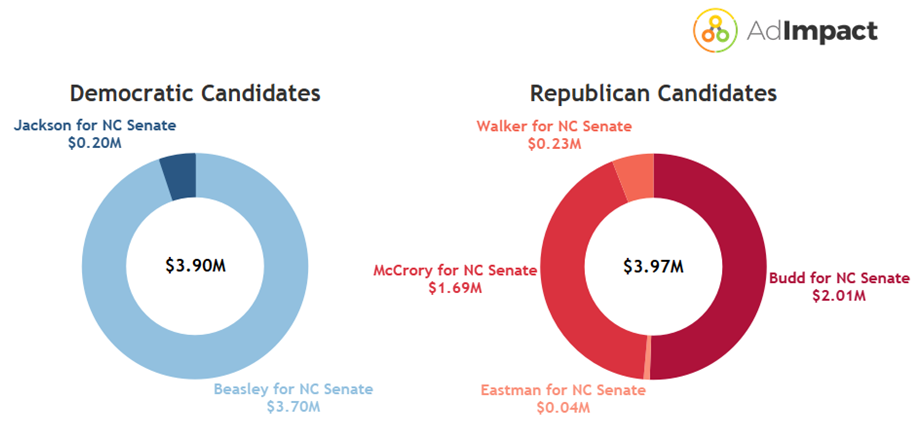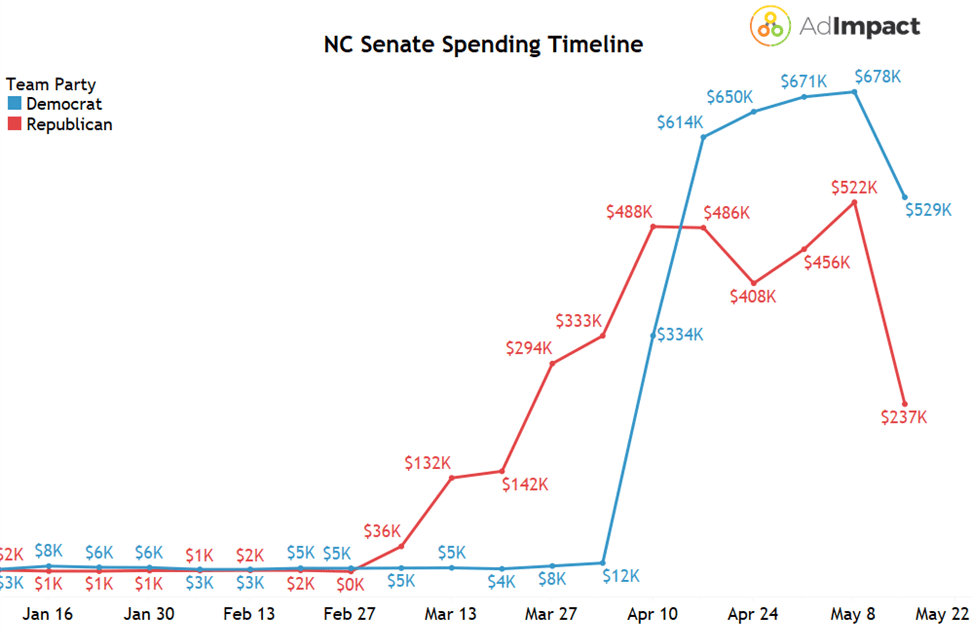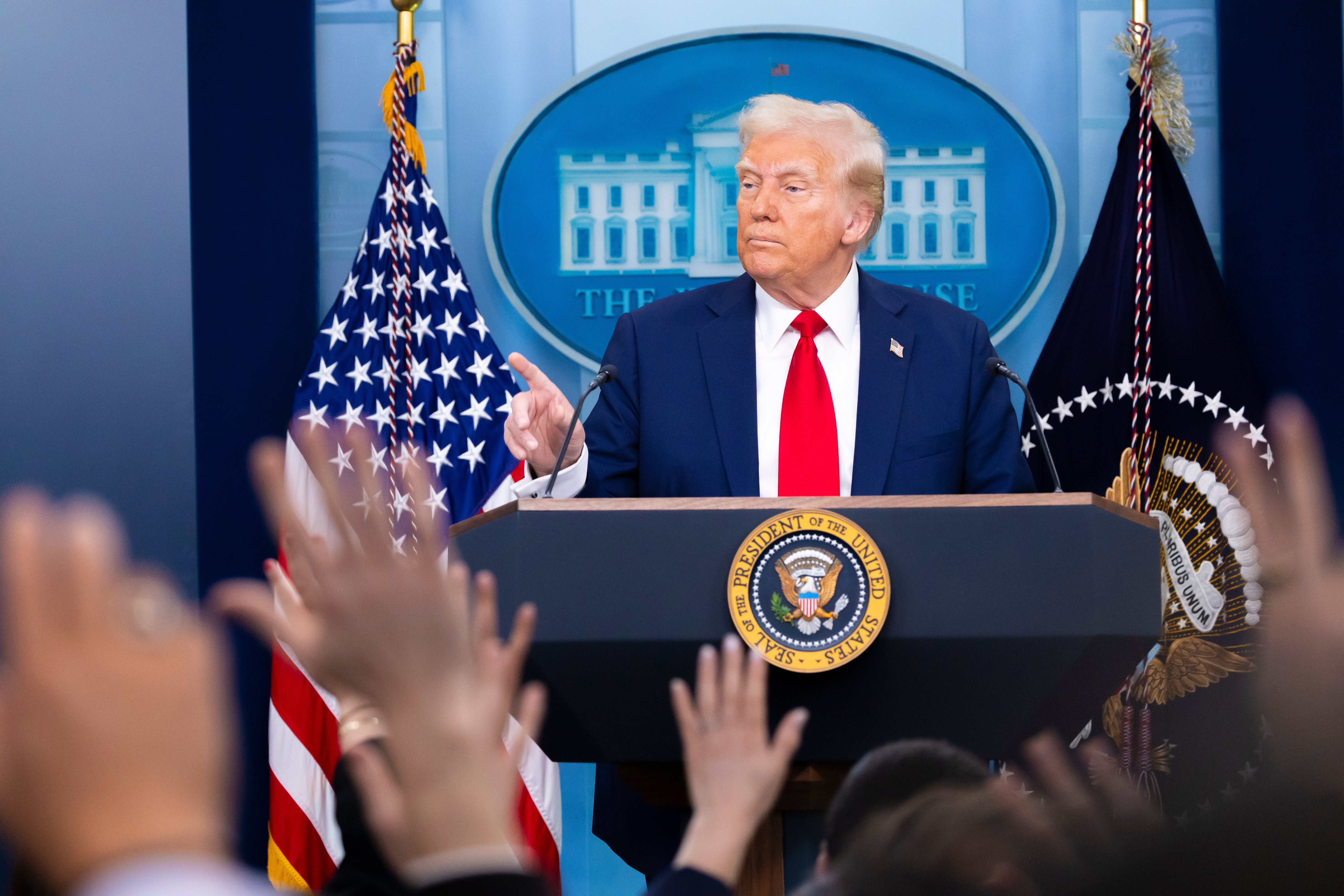Following the 2020 Census, North Carolina went through major GOP-led redistricting. The Census concluded that North Carolina would now have 14 congressional districts, which led to a lengthy redistricting process. In December 2021, lawmakers announced that the North Carolina primary elections would be delayed giving the legislature more time to settle two lawsuits challenging the redrawn maps. Once approved, the redrawn map included several districts that are considerably competitive. Up for grab in the NC midterms are a Senate seat, 14 Congressional seats, State Senate and State House positions, two state Supreme Court seats, as well as local government positions and ballot measures giving much content in this primary to explore through an analytics deep dive.
North Carolina primary elections pooled in over $45.5M across all media types. Republicans spent $33.7M, almost three times as much as democrats ($11.7M). We recorded $30.4M on broadcast, $9.2M on cable, $2.2M on radio, $1.9M on satellite, and $1.9M on digital. We also recorded $2.3M in spending on CTV devices from 49 different advertisers.
Republicans outspent democrats in every market. The highest spending market was the Raleigh-Durham market, which recorded $18.9M.

Below are spending insights on two of North Carolina’s most competitive and expensive primaries.
North Carolina Senate Analytics
Retiring Senator Richard Burr (R) is opening up one seat in the Senate. Eleven democratic and 14 republican candidates are on the ballot in each respective primary. Overall, we saw $25.5M in spending for NC Senate. Candidate campaigns saw $7.8M from seven candidates, four republicans and three democrats.

The top democrat spender was Cheri Beasley, who spent $3.7M out of the total $3.9M spent by democratic candidates. Beasley served on the North Carolina Supreme Court from 2012-2020 but has since declared her candidacy for Senate. Beasley’s ads focused on her successes as Chief Justice; her campaign spent $591K on an ad describing her work to reduce the human trafficking problem in North Carolina. If she wins in November, Beasley will become North Carolina’s very first Black Senator.
The top republican spending candidate was Ted Budd, who spent $2.0M of the total $3.97M spent by GOP candidates. Budd, who received the GOP’s coveted Trump endorsement, is a current member of the U.S. House, representing North Carolina’s 13th Congressional District. Budd’s ads highlighted Trump’s praise and endorsement, as well as criticized Joe Biden.
In addition, the NC Senate primary saw $17.6M in spending from issue groups across media types. Issue group spending targeted the republican candidates. The highest spending issue group, Club for Growth Action, spent $11.9M on ads in support of Ted Budd.
While republican advertisers were outspending democratic advertisers until the week of April 10, spending from democrats skyrocketed when Beasley started spending over $600K per week. Budd’s spending also steadily increased around April when he received Trump’s endorsement. Pat McCrory (R), former governor of North Carolina, spent all his $1.7M between March 16 and May 15.

The day before the primary, Ted Budd had a favorable lead in the republican primary poll, and he will again test the power of Trump’s endorsements. In the most recent democratic primary polls, Beasley had a healthy lead ahead of her competitors.
North Carolina’s 13th Congressional District Deep Dive
North Carolina’s newly drawn 13th District is considered a toss-up leading up to the November general election. According to FiveThirtyEight, North Carolina’s old 13th district had a +38 lean for republicans, but the newly drawn district only has a +3 GOP lean, making it one of the most competitive districts in the state. 13 candidates are vying for the seat, and we recorded spending from eight of those candidates. Overall, the NC CD-13 primary saw $7.1M in spending from 14 different advertisers.
Republicans came in strong to the new swing district, outspending democrats $6.3M to $833K. The top spending candidate was Kelly Daughtry (R), who started spending in February 2022. Daughtry is a self-described “old-fashioned, tight-fisted conservative,” and has received endorsements from US Representatives Madison Cawthorn (R-NC) and Matt Gaetz (R-FL). Her most frequently aired ad talks about her priorities to secure the border, stop inflation, and back the police and military.
Just two of the five democrats spent on advertisements leading up to the primary. Former State Senator Wiley Nickel was the top democrat advertiser, spending $563K on ads that emphasized his focus on advocating for civil rights in North Carolina. Nickel and Sam Searcy (D), a current member of the NC State Senate who spent $271K, lead in recent democratic polls.

We saw spending from four issue groups, totaling $3.1M. Issue groups targeted Trump endorsed Bo Hines (R), with $2.17M in support of him and $860K opposing Hines. Bo Hines is a 26-year-old who has not yet served in office, and is being compared to Madison Cawthorn, who represents North Carolina’s 11th District.

Old North PAC used all of the $860K spent opposing Hines, airing ads that called Bo Hines a “career politician” and attacked him for not being right-winged enough. Club for Growth Action heavily highlighted Hines’ Trump endorsement in their ads supporting the 26-year-old. The conservative issue group dropped $1.2M on ads supporting Hines.
North Carolina’s rules require candidates to obtain more than 30% of votes to avoid a runoff. With such close races, runoffs could be on the horizon. We have already tracked over $26M in prebooked spending towards the North Carolina general election and will continue tracking spending for the state and running analytics after the primary.









